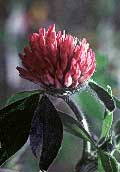
Photo © Steven Foster
A member of the pea family and closely related to alfalfa, red clover is often used as a forage crop for cattle or poultry. It is also used as a cover crop to increase soil fertility. Both alfalfa and red clover make tasty sprouts in a winter salad, too.
Herbally, red clover is a blood purifier and is often used to clear up skin conditions like acne, rashes and eczema. The herb is also used to treat overactive, dry, irritable or inflamed skin because of its soothing, cooling and moistening properties. It is typically combined with other blood purifying herbs like burdock and yellow dock, as in the blood purifying formulas BP-X and Enviro-Detox. It is also in the laxative formula LBS II.
Red clover is a mild expectorant. In Russia, folk healers treat asthmatic patients with red clover. It is used in Ireland for winter colds. It has also been used for coughs, whooping cough, wheezing and bronchitis.
Red clover increases lymph flow, which helps to detoxify the body and reduce inflammation. This helps explain its use in treating arthritis, rheumatism, sore throats, skin sores and eye irritations. It is a key ingredient in Lymphatic Drainage Formula, a blend that reduces lymphatic congestion.
Some Native American tribes used red clover to treat gynecological problems. There is a good reason for this. Red clover contains isoflavones that have phytoestrogenic activity. Phytoestrogens can be helpful for menopause and for regulating the female cycle. More importantly, they can be helpful in preventing and treating estrogen-dependent cancers by competing for estrogen receptor sites with xenostrogens.
Xenoestrogens are environmental estrogens that are believed to be responsible for the rising rates of breast, uterine and prostate cancer. These environmental estrogens overstimulate estrogen dependent tissues and contribute to the growth of cysts and tumors. Phytoestrogens help block these effects.
This also helps to explain why one of the primary historical uses for red clover is as an anticancer remedy. Research done by the National Cancer Institute has proven that four antitumor properties do exist in red clover. Besides phytoestrogens, red clover contains rather high amounts of tocopherol, a form of vitamin E that has been shown to help prevent breast tumors in animals.
Red clover has been studied as a natural cancer treatment for over one hundred years and about thirty-three cultures around the world use this common herb to treat cancer today. It is a key ingredient, along with burdock, in many anti-cancer herbal formulas. For example, NSPís Red Clover Blend (red clover, burdock, pau díarco) was originally based on an anticancer remedy called Jason Winterís tea. Red clover and burdock are also the key ingredients in the famous Hoxsey cancer formula.
Red clover has also been used topically for cancers in drawing salves. Traditionally these salves were made by boiling a decoction of red clover down to a thick paste. This was applied topically to draw infection, tumors, cysts and warts. This is why it is an ingredient in NSPís Black Ointment, a drawing salve for pulling out infection.
I also use red clover as a flower essence. It keeps one calm in the midst of a crisis and stay clear of the group mind set. If all the bad news about the economy is adversely affecting you, this flower essence might be just what you need.
Itís clear to see that this simple wayside herb is a powerful ally in our quest for better health. So, in your search for remedies, never overlook whatís growing in your own backyard.
Selected References
- A Handbook of Native American Herbs
by Alma R. Hutchens
- Herbal Healing by Michael J. Hallowell
- Nutritional Herbology
by Mark Pedersen
- The Energetics of Western Herbs
s by Peter Holmes
- The Healing Herbs by Michael Castleman
- The Wild Rose Scientific Herbal
by Terry Willard, Ph.D.

